“Horse Vahana” has been added to your cart.
View cart
-
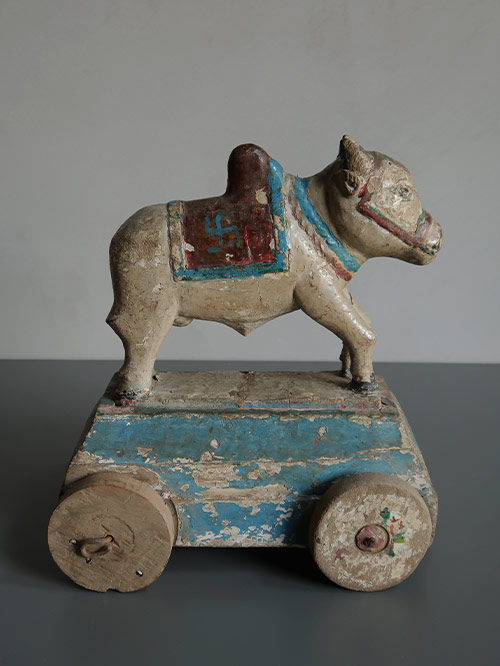
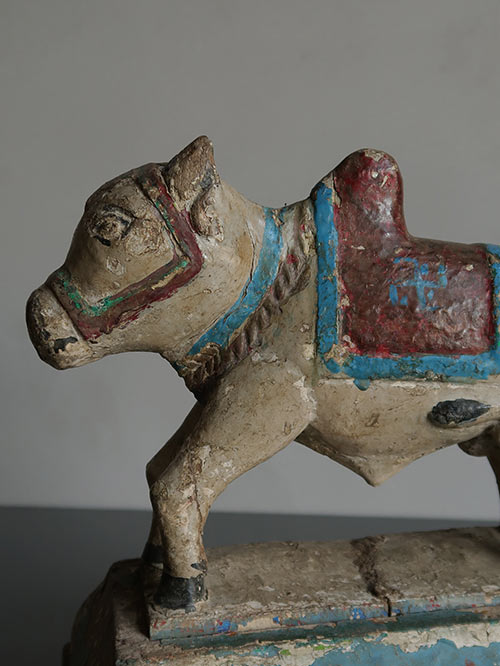
Maharashtra/Karnataka
Wood, polychromed
A decorative Nandi painted with patterns symbolising typical trappings including a saddle and head and neck ornaments. A right-facing swastik is painted on the saddle, symbolizing the sun, prosperity and good luck. The Nandi stands on a pedestal with wheels. Animal festival toys are used for ritual display and celebration during important festivities such as Pola, Holi, Shivaratri and Durga Puja.
Nandi festival toys have a special importance during the festival of Pola. Pola is an ancient thanks giving festival celebrated during the Hindu month of Sharavan during which farmers celebrate their cattle.
Nandi or Nandin means rejoicing, gladdening. It is the name of Shiva’s conveyance (vahana) the white bull, son of Kashyapa and of Surabhi. Nandi was probably a folk deity later incorporated into the Brahmanic lore. Nandi symbolises on the one hand moral and religious duty (dharma), and on the other, virility, fertility and strength. Apart from being Shiva’s vehicle, nandi in his form as nandikeshvara, depicted as a human with a bulls head, is believed to be one of the great masters of music and dancing. In southern India his recumbent image is placed either opposite the main sanctuary or in the hall leading to it, facing the linga.
Size (cms): 33.5(H) x 30(W) x 20(D)
Size (inches): 13(H) x 12(W) x 8(D)
-
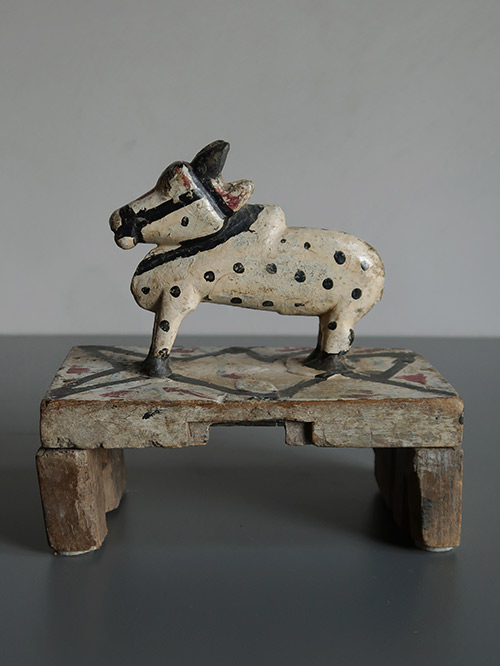
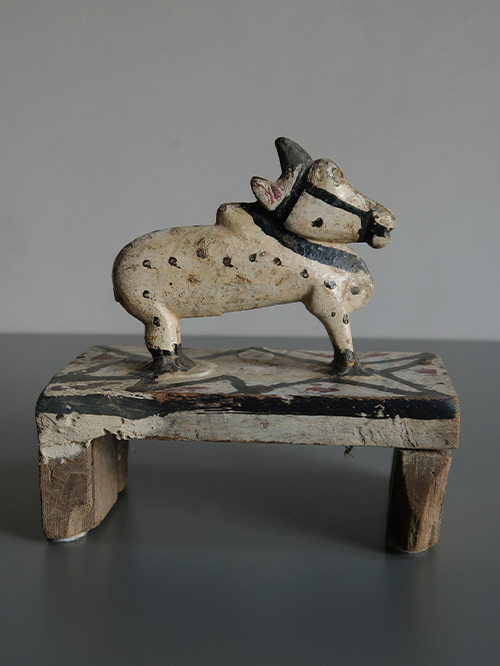
Maharashtra/Karnataka
Wood, polychromed
A decorative Nandi painted in white with black dots and typical trappings including a bridle bit. The Nandi stands on a pedestal painted with a geometric star. Animal festival toys are used for ritual display and celebration during important festivities such as Pola, Holi, Shivaratri and Durga Puja.
Nandi festival toys have a special importance during the festival of Pola. Pola is an ancient thanks giving festival celebrated during the Hindu month of Sharavan during which farmers celebrate their cattle.
Nandi or Nandin means rejoicing, gladdening. It is the name of Shiva’s conveyance (vahana) the white bull, son of Kashyapa and of Surabhi. Nandi was probably a folk deity later incorporated into the Brahmanic lore. Nandi symbolises on the one hand moral and religious duty (dharma), and on the other, virility, fertility and strength. Apart from being Shiva’s vehicle, nandi in his form as nandikeshvara, depicted as a human with a bulls head, is believed to be one of the great masters of music and dancing. In southern India his recumbent image is placed either opposite the main sanctuary or in the hall leading to it, facing the linga.
Size (cms): 21(H) x 20(W) x 12(D)
Size (inches): 8.5(H) x 8(W) x 4.5(D)
-
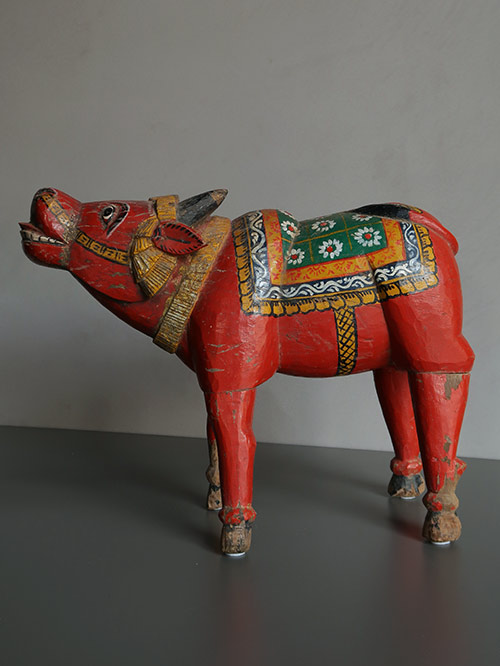
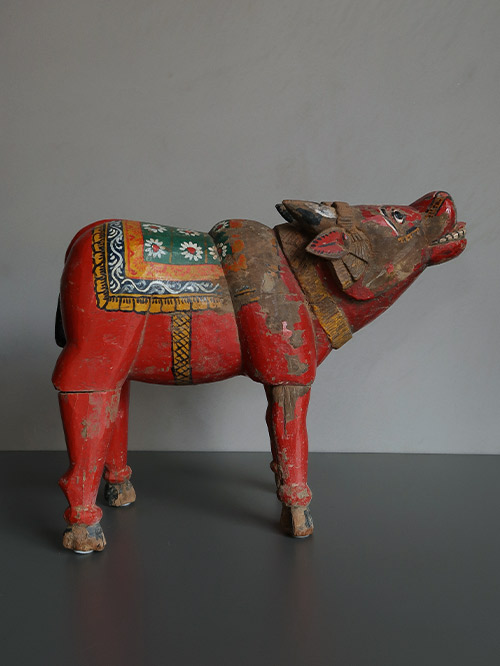
Coastal Karnataka (Bhuta culture)
Wood, polychromed
A large painted wood figure of a standing nandi. Displaying the typical folk bhuta style of coastal Karnataka, this figure is painted predominantly in red with a floral painted saddlecloth and a curled back tail resting on its back.
The bhuta tradition is popular on the Malabar coast. Bounded by the dramatic sweep of the forested ghats to the east and the Arabian sea to the west, and encircled by rivers, the South Kanara district of coastal Karnataka has enjoyed relative geographic isolation until recent years. The totemic origin of this bull bhuta is quite obvious in a land of agriculture and farms where ploughs are pulled by bulls and where cow milk is one of the main sources of protein. The link with Hinduism is also easily established through Nandi the vahana (“vehicle”) of god Shiva.
Size (cms): 36(H) x 46(W) x 16(D)
Size (inches): 14(H) x 18(W) x 6.5(D)
-
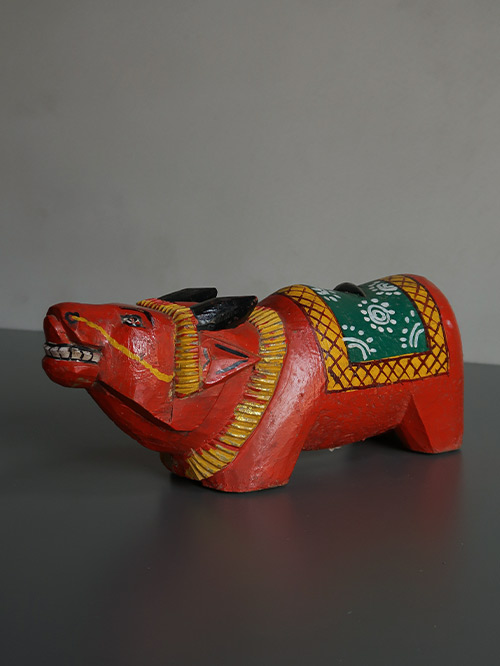
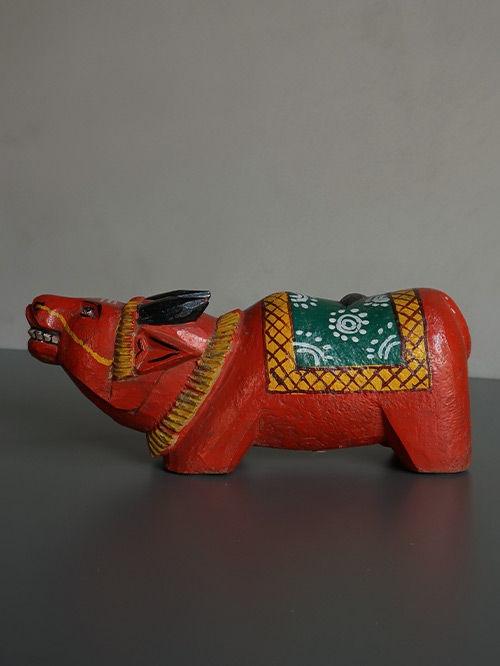
Coastal Karnataka (Bhuta culture)
Wood, polychromed
A fine painted wood figure of a standing nandi. Displaying the typical folk bhuta style of coastal Karnataka, this figure is painted predominantly in red It displays a typical stylised form with a horizontal head with slightly protruding tongue, horns adorned with ornaments, a floral painted saddlecloth and a curled back tail resting on its back.
The bhuta tradition is popular on the Malabar coast. Bounded by the dramatic sweep of the forested ghats to the east and the Arabian sea to the west, and encircled by rivers, the South Kanara district of coastal Karnataka has enjoyed relative geographic isolation until recent years. The totemic origin of this bull bhuta is quite obvious in a land of agriculture and farms where ploughs are pulled by bulls and where cow milk is one of the main sources of protein. The link with Hinduism is also easily established through Nandi the vahana (“vehicle”) of god Shiva.
Size (cms): 14(H) x 35.5(W) x 11(D)
Size (inches): 5.5(H) x 14(W) x 4.5(D)
-

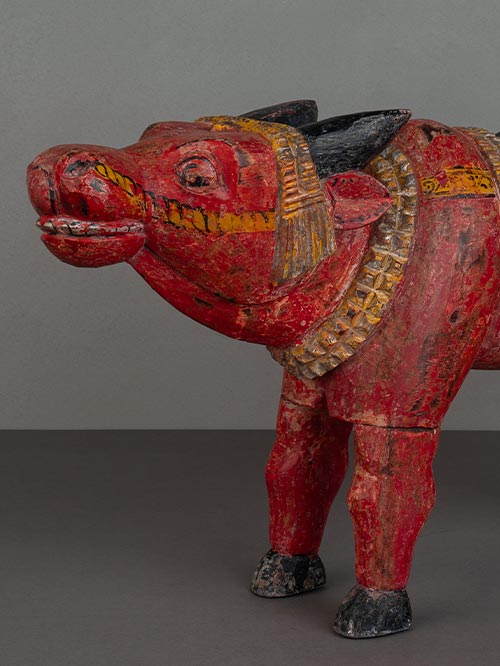
Coastal Karnataka (Bhuta culture)
Wood, polychromed
A fine painted wood figure of a standing nandi. Displaying the typical folk bhuta style of coastal Karnataka, this figure is painted predominantly in red with a painted saddlecloth and a curled back tail resting on its back.
The bhuta tradition is popular on the Malabar coast. Bounded by the dramatic sweep of the forested ghats to the east and the Arabian sea to the west, and encircled by rivers, the South Kanara district of coastal Karnataka has enjoyed relative geographic isolation until recent years. The totemic origin of this bull bhuta is quite obvious in a land of agriculture and farms where ploughs are pulled by bulls and where cow milk is one of the main sources of protein. The link with Hinduism is also easily established through Nandi the vahana (“vehicle”) of god Shiva.
Size (cms): 32(H) x 52(W) x 14(D)
Size (inches): 12.5(H) x 20.5(W) x 5.5(D)
-
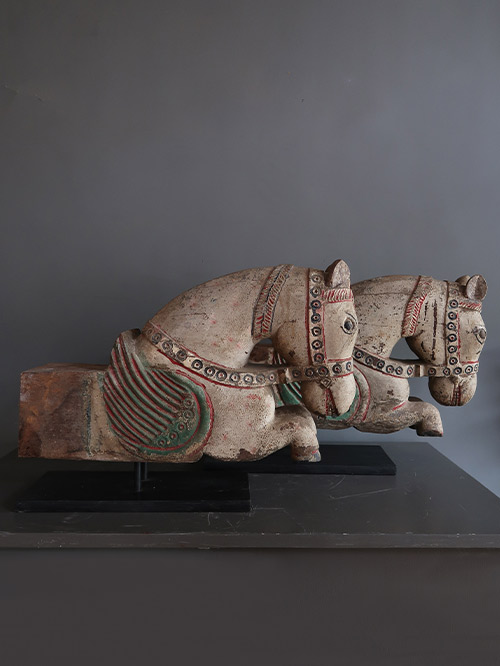

Andhra Pradesh (South India)
Wood
These horse brackets once formed the two ends of a door lintel. The horse or ashva was a very popular motif in architectural wood carvings in South India. Its prototype, the divine Uchchaihshravas emerged from the churning of the ocean. It was white and endowed with wings. The god Indra appropriated it and, after cutting its wings to ensure that it would remain on earth, donated it to mankind.
The horse played a pivotal role in establishing the supremacy of kings, as demonstrated, for instance by the great horse sacrifice, the Ashvamedha, which might have been established in the course of the Vedic period. Equestrian motifs appear prominently in Indian art, for example in Orissan sculpture of the 12th and 13th centuries, and in that of the late Vijaynagara and Nayak periods (early 16th to early 18th century) in southern India. There is a branch of literature specialising in the training of horses, which contains detailed passages on colouring, proportions, gait, auspicious and inauspicious marks and lists of appropriate names for horses.
Individual Sizes (cms): 36 (H) x 61 (W) x 15 (D)
Individual Sizes (inches): 14.2 (H) x 24 (W) x 5.9 (D)
-
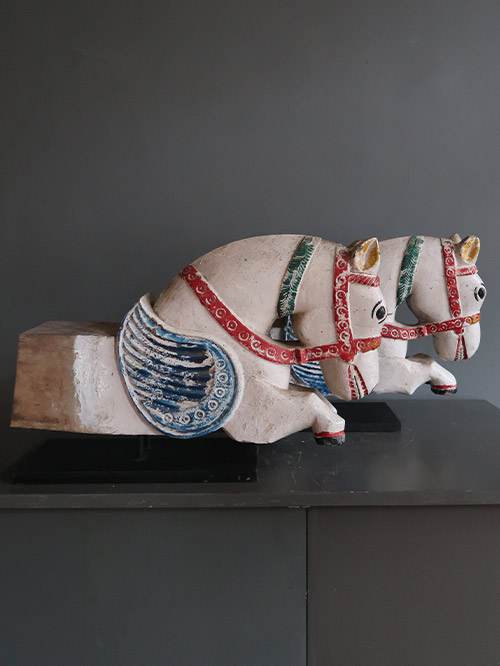
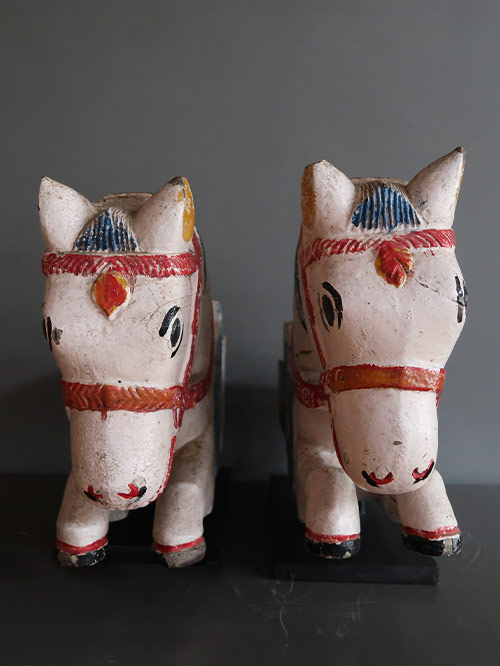
Andhra Pradesh (South India)
Wood
These horse brackets once formed the two ends of a door lintel. The horse or ashva was a very popular motif in architectural wood carvings in South India. Its prototype, the divine Uchchaihshravas emerged from the churning of the ocean. It was white and endowed with wings. The god Indra appropriated it and, after cutting its wings to ensure that it would remain on earth, donated it to mankind.
The horse played a pivotal role in establishing the supremacy of kings, as demonstrated, for instance by the great horse sacrifice, the Ashvamedha, which might have been established in the course of the Vedic period. Equestrian motifs appear prominently in Indian art, for example in Orissan sculpture of the 12th and 13th centuries, and in that of the late Vijaynagara and Nayak periods (early 16th to early 18th century) in southern India. There is a branch of literature specialising in the training of horses, which contains detailed passages on colouring, proportions, gait, auspicious and inauspicious marks and lists of appropriate names for horses.
Individual Size (cms): 40(H) x 64(W) x 18(D)
Individual Size (inches): 15.5(H) x 25(W) x 7(D)
-
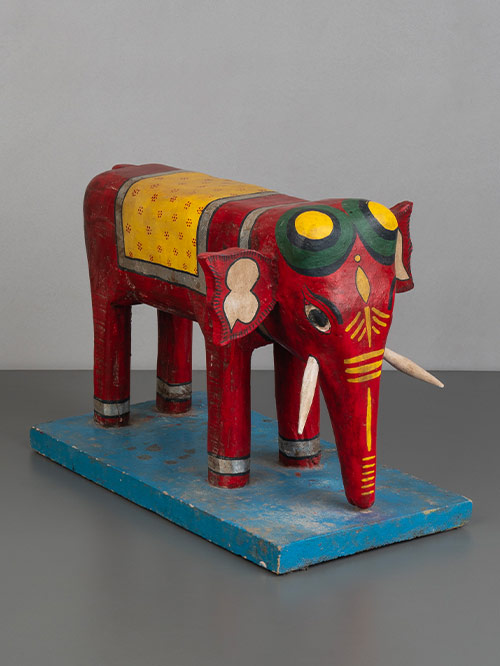

Karnataka
Wood, extensively polychromed
An eye-catching folk elephant vahana that would have been a part of a processional figure depicting the Goddess Durga. The carefully painted frontal features, including the head, trunk, and ears, suggest that the elephant was intended to be displayed headlong, while the back half was designed with functionality in mind, ensuring balance for the deity placed on top.
Every year, during Navratri, processional images of the Goddess are carried in evocative ceremonies. Depending on the day of the festival, her vahana, the vehicle on which she rides changes, with each of her vehicles holding a different and unique significance. The elephant she rides here signifies happiness and prosperity.
Size (cms): 29(H) x 41(W) x 20.5(D)
Size (inches): 11.5(H) x 16(W) x 8(D)
-
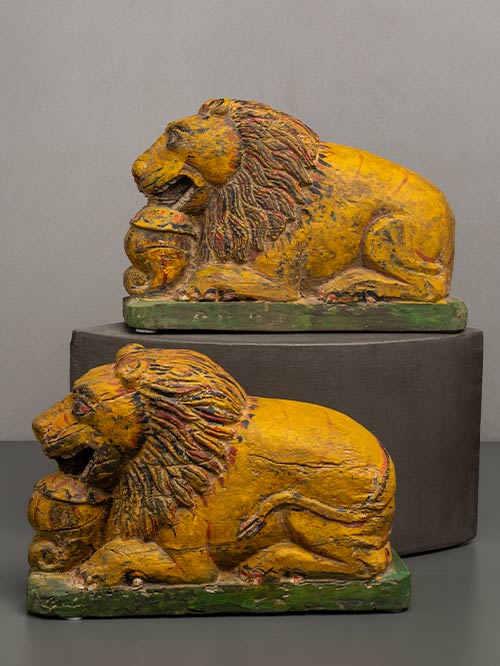
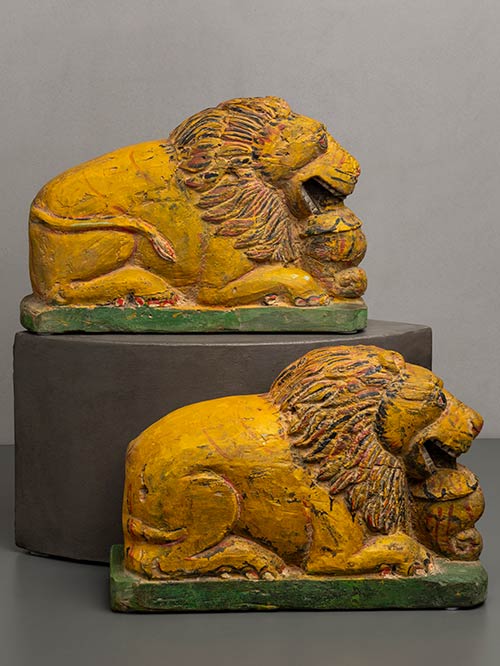
Karnataka
Wood, extensively polychromed
A charming pair of painted wooden lions with bulging eyes and prominent ‘sunburst’ manes. Laying in a prone positions, their fore and hind legs are well carved and terminate in large claws.
The lion holds a special significance in Hindu mythology, being the sacred vehicle of the goddess Durga. Often regarded as India’s embodiment of Mother Nature, Durga symbolizes energy and vitality. Lions, in Hindu iconography, represent attributes like power, royalty, and nobility. They are frequently portrayed as guardians and protectors in various mythological narratives.
Size (cms): 21.5(H) x 32.5(W) x 13(D) each
Size (inches): 8.5(H) x 13(W) x 5(D) each
-
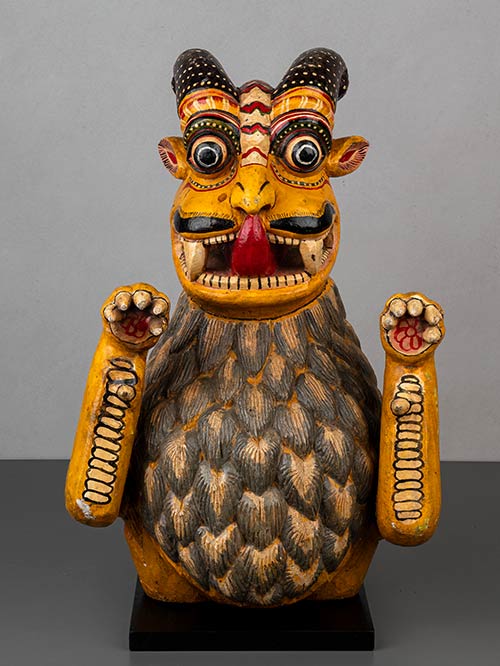

Karnataka
Wood, extensively polychromed
This striking large Tiger Vahana with an unusual, prominent flowing mane. The tiger has wide bulging eyes and an open mouth with large exposed teeth and a long protruding tongue. His fore legs are raised, as if to pounce.
The tiger is the vehicle of, and sacred to, the Hindu goddess, Durga. From a certain perspective she is India’s Mother Nature, for she is the deification of Energy. Her consort, Shiva, sometimes evoked as Shambo, wears a tiger skin to indicate that he is beyond the bounds of the natural world.
Size (cms): 61(H) x 38(W) x 27(D)
Size (inches): 24(H) x 15(W) x 10.5(D)
-

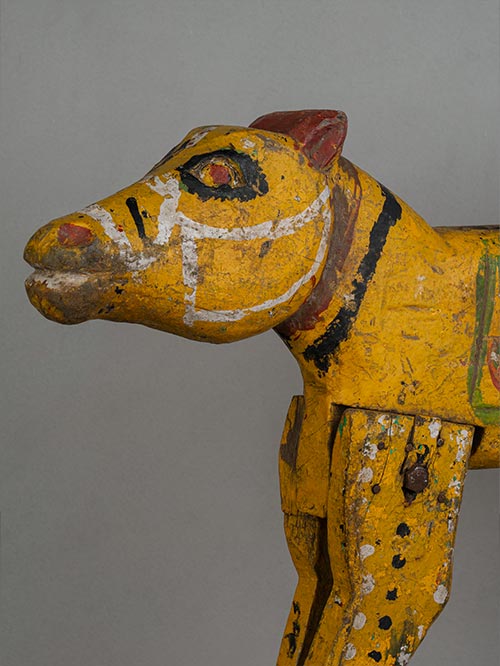
Maharashtra/Karnataka
Wood polychromed
An attractive folk carousel animal in the shape of a dog with original polychroming.
According to Hindu mythology, the dog was originally created by Brahma who then asked him to find and serve the greatest creature on earth. The dog, understandably, settled upon the elephant as his master. However, when he was rebuked for barking at night, lest he attract the attention of a lion, he realised he had made the wrong choice and decided to serve the lion instead. But the lion in turn complained that his bark would attract a hunter. Finally the dog found its right master, the hunter, who abided his barking without fear of a more powerful creature.
Size (cms): 50(H) x 70(W) x 10(D)
Size (inches): 19.5(H) x 27.5(W) x 4(D)
-


Maharashtra/Karnataka
Wood polychromed
An attractive folk carousel animal in the shape of a horse with original polychroming.
The horse played a pivotal role in establishing the supremacy of kings, as demonstrated, for instance by the great horse sacrifice, the Ashvamedha, which might have been established in the course of the Vedic period. Equestrian motifs appear prominently in Indian art, for example in Orissan sculpture of the 12th and 13th centuries, and in that of the late Vijaynagara and Nayak periods (early 16th to early 18th century) in southern India. There is a branch of literature specialising in the training of horses, which contains detailed passages on colouring, proportions, gait, auspicious and inauspicious marks and lists of appropriate names for horses.
Size (cms): 54.5(H) x 71.5(W) x 10.5(D)
Size (inches): 21.5(H) x 28(W) x 4(D)
-
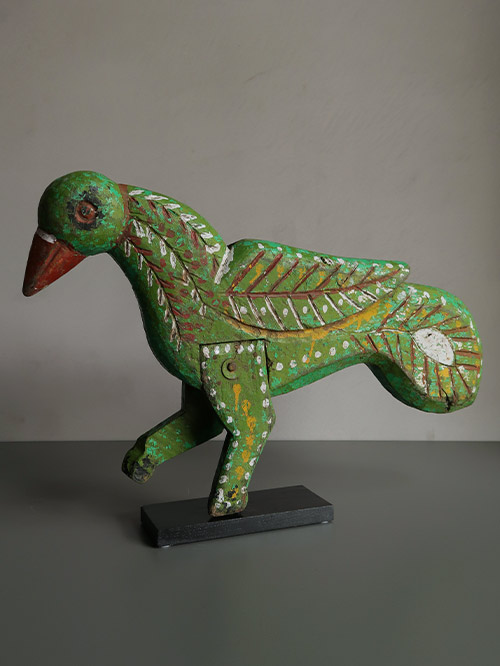
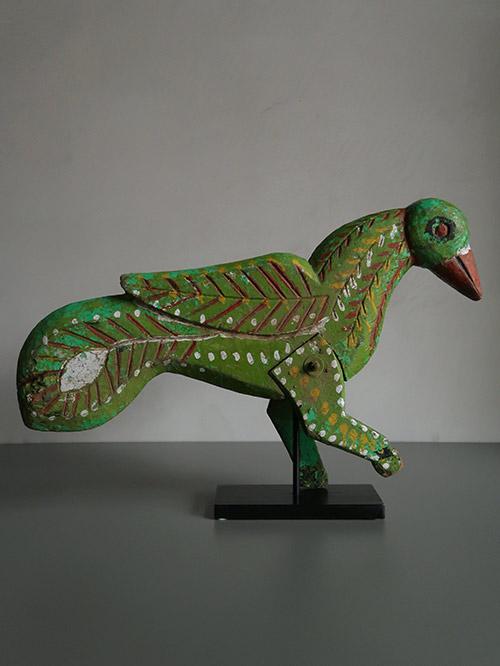
Maharashtra/Karnataka
Wood polychromed
An attractive folk carousel animal in the shape of a parrot with original polychroming. The parrot is the vehicle (vahana) of Kama – the god of love. Generally depicted riding on a parrot, Kama is depicted armed with a bow made of sugar cane (ikshukodanda) bearing a string formed by a row of buzzing bees, five flowertipped arrows, symbolizing the five senses, and on his banner the Makara, an aquatic monster.
Size (cms): 47.5(H) x 70(W) x 10(D)
Size (inches): 18.5(H) x 27.5(W) x 4(D)
-
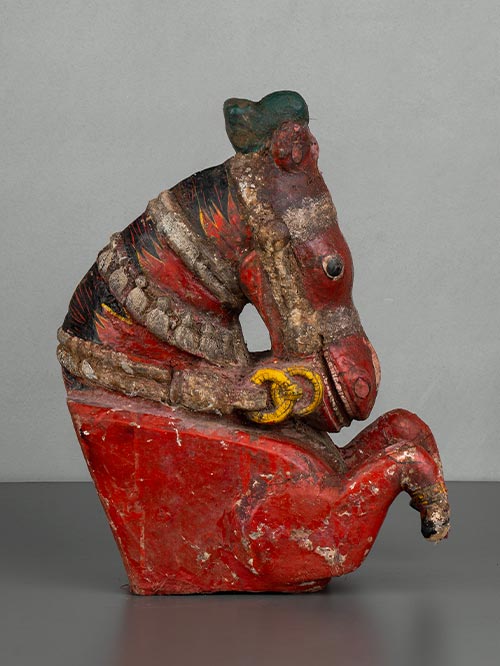
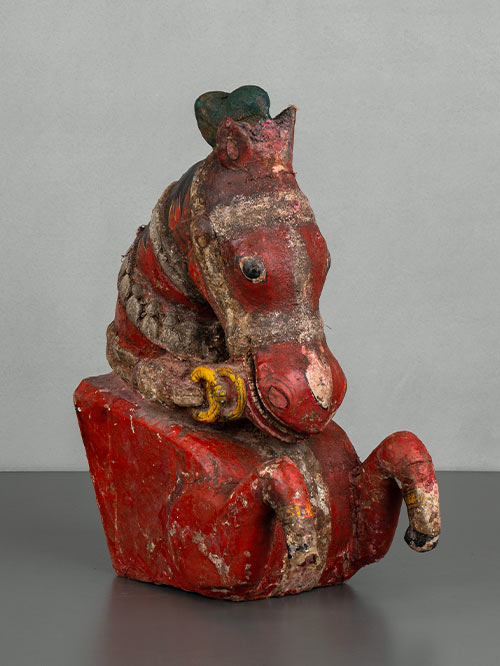
Karnataka
Wood polychromed
A delightful, richly polychromed horse vahana that would have been a part of a processional figure depicting the Goddess Durga. Every year, during Navratri, processional images of the Goddess are carried in evocative ceremonies. Depending on the day of the festival, her vahana, the vehicle on which she rides changes, with each of her vehicles holding a different and unique significance. The horse she rides here signifies her readiness for battle.
The horse played a pivotal role in establishing the supremacy of kings, as demonstrated, for instance by the great horse sacrifice, the Ashvamedha, which might have been established in the course of the Vedic period. Equestrian motifs appear prominently in Indian art, for example in Orissan sculpture of the 12th and 13th centuries, and in that of the late Vijaynagara and Nayak periods (early 16th to early 18th century) in southern India. There is a branch of literature specialising in the training of horses, which contains detailed passages on colouring, proportions, gait, auspicious and inauspicious marks and lists of appropriate names for horses.
Size (cms): 40(H) x 31(W) x 16(D)
Size (inches): 15.5(H) x 12(W) x 6.5(D)
-
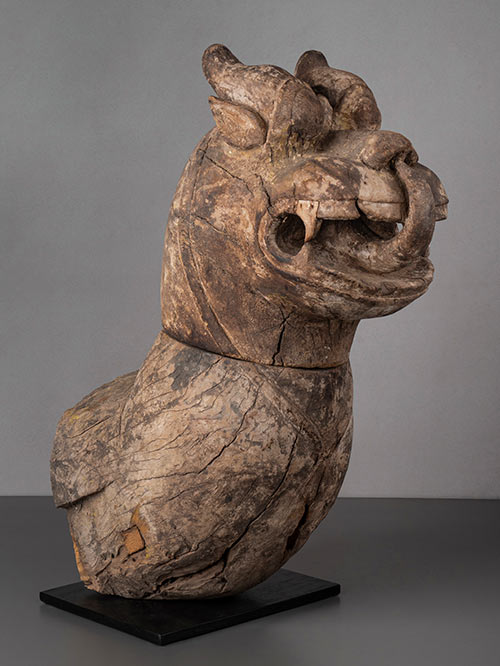

Karnataka
Wood
‘Yali’ or ‘Vyala’ denotes a mythical lion faced animal that appears on carved friezes on temple walls. They are fierce, leonine beasts with curvaceous bodies and enlarged heads surrounded by flame-like manes. They rear up on hind legs, the forelegs held out with clenched claws as if to pounce. Sometimes they are shown standing on human heads presumably of the demons that they have vanquished. In southern Indian sculpture from the 16th century onwards figures of rearing, almost three dimensional vyalis bearing heads either of horned lions or elephants and feline bodies guard the entrances of temples and line the approaches leading to sanctuaries.
Size (cms): 65(H) x 29(W) x 61(D)
Size (inches): 25.5(H) x 11.5(W) x 24(D)































